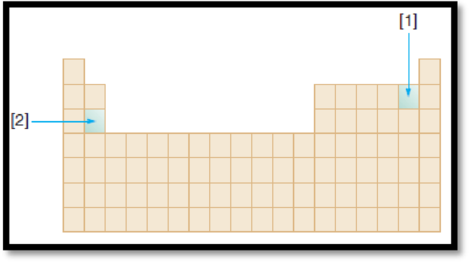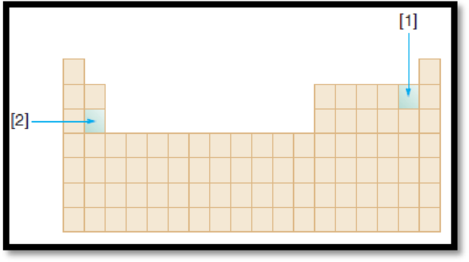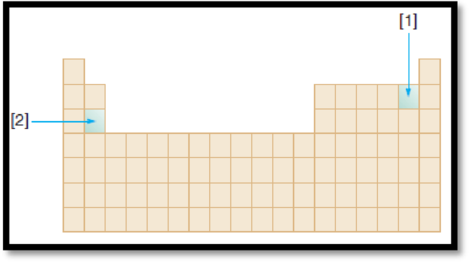
(a)
Interpretation:
The atom with smaller atomic radius has to be given.
The given diagram is,

Figure 1
Concept Introduction:
Atomic Radius:
Atomic radius is the distance from the centre of the nucleus to the outermost shell containing electrons. The atomic radius of an element decreases along the period and increases down the group.
(b)
Interpretation:
The atom with lower ionization energy has to be given.
The given diagram is,

Figure 1
Concept Introduction:
Ionization energy:
Ionization energy is defined as the energy required removing one mole of electron from one mole of isolated gaseous atom or ion. Ionization energy of an element increases along the period and decreases down the group.
(c)
Interpretation:
The elements in the diagram have to be identified.
The given diagram is,

Figure 1
Want to see the full answer?
Check out a sample textbook solution
Chapter 2 Solutions
Principles of General, Organic, Biological Chemistry
- (a) Describe the trends of atomic size and ionization energy, respectively, in the Periodic Table: (1) from left to right across a period, and (ii) from top to bottom down a group. (b) Rank the following elements: Na, Mg, Al, and K, in increasing order of: (i) atomic size; (ii) ionization energy, and (iii) reactivity. (c) Rank the following elements: F, CI, Br and I, in increasing order of: (i) atomic size; (ii) electron affinity, (iii) electronegativity, and (iv) reactivity.arrow_forwardQuestion:Consider two elements, Element A and Element B, from the periodic table. Element A is located in Group 1 and Period 3, while Element B is located in Group 16 and Period 2. (a) Which element would have a larger atomic radius, Element A or Element B? Justify your answer. (b) Predict the ionization energy of Element A and Element B. Which element would have a higher ionization energy? Explain your reasoning. (c) Based on their positions in the periodic table, which element would be more likely to form a stable cation? Provide a brief explanation for your choice.arrow_forwardArrange in order of increasing ionization energy. (a) the Group 1A elements H, Li, and Cs (b) the Period 4 elements As, K, & Searrow_forward
- Boron, atomic number 5, occurs naturally as two isotopes, 10B and 11B, with natural abundances of 19.9% and 80.1%, respectively. (a) In what ways do the two isotopes differ from each other? Does the electronic configuration of 10B differ from that of 11B? (b) Draw the orbital diagram for an atom of 11B. Which electrons are the valence electrons? (c) Indicate three ways in which the 1s electrons in boron differ from its 2s electrons. (d) Elemental boron reacts with fluorine to form BF3, a gas. Write a balanced chemical equation for the reaction of solid boron with fluorine gas. (e) ΔHf° for BF3(g) is -1135.6 kj/mol. Calculate the standard enthalpy change in the reaction of boron with fluorine. (f) Will the mass percentage of F be the same in 10BF3 and 11BF3? If not, why is that the case?arrow_forwardWhich of the following elements is expected to have the highest SECOND IONIZATION ENERGY: (A) Be (B) Ca (C) Mg (D) Naarrow_forward(a) Why do successive IEs of a given element always increase? (b) When the difference between successive IEs of a given element is exceptionally large (for example, between IE1 and IE2 of K), what do we learn about its electron configuration? (c) The bars represent the relative magnitudes of the first five ionization energies of an atom: Identify the element and write its complete electron config uration, assuming it comes from (a) Period 2; (b) Period 3; (c) Period 4.arrow_forward
- Boron, atomic number 5, occurs naturally as two isotopes, 10B and 11B, with natural abundances of 19.9% and 80.1%, respectively.(a) In what ways do the two isotopes differ from each other? Does the electronic configuration of 10B differ from that of 11B? (b) Drawthe orbital diagram for an atom of 11B. Which electrons are the valence electrons? (c) Indicate three ways in which the 1s electrons inboron differ from its 2s electrons. (d) Elemental boron reacts with fluorine to form BF3, a gas. Write a balanced chemical equation forthe reaction of solid boron with fluorine gas. (e) ΔHf° for BF31g2 is -1135.6 kJ>mol. Calculate the standard enthalpy change in thereaction of boron with fluorine. (f) Will the mass percentage of F be the same in 10BF3 and 11BF3? If not, why is that the case?arrow_forward(a) Write out the full electron configuration of Calcium (Ca). (b) How many electrons are in the n=3 shell of Calcium?arrow_forwardWhat are ionization energy for atoms : (a) Sr (b) P (c) Rbarrow_forward
- Write the ground-state electron configurations of the following ions. (a) Li+ (b) N3− (c) In3+ (Use the noble gas core electron configuration in your answer.) (d) Tl+ (Use the noble gas core electron configuration in your answer.)arrow_forward2. The ionization energy of an element is defined as the amount of energy required to remove an electron from an individual atom. The following table gives the ionization energy (in units of kilojoules per mole) for five metals, listed in alphabetical order. Locate each of these metals on the periodic table and arrange them in order of rows and columns as in the periodic table. (a) Describe the periodic trend in the ionization energy of elements within a group. (b) Describe the periodic trend in the ionization energy of elements across a period. Metal Calcium Magnesium Potassium Sodium Strontium Ionization Energy 590 738 419 496 549 Materialsarrow_forwardQ1. This question is about atomic structure. (a) Write the full electron configuration for each of the following species. CH Fe2+ (b) Write an equation, including state symbols, to represent the process that occurs when the third ionisation energy of manganese is measured. (c) State which of the elements magnesium and aluminium has the lower first ionisation energy Explain your answer. (d) A sample of nickel was analysed in a time of flight (TOF) mass spectrometer. The sample was ionised by electron impact ionisation. The spectrum produced showed three peaks with abundances as set out in the table. m/z Abundance /% 58 61.0 60 29.1 61 9.9 Give the symbol, including mass number, of the ion that would reach the detector first in the sample. Calculate the relative atomic mass of the nickel in the sample. Give your answer to one decimal place. Page 2 of 12 Symbol of ion Relative atomic massarrow_forward
 World of Chemistry, 3rd editionChemistryISBN:9781133109655Author:Steven S. Zumdahl, Susan L. Zumdahl, Donald J. DeCostePublisher:Brooks / Cole / Cengage Learning
World of Chemistry, 3rd editionChemistryISBN:9781133109655Author:Steven S. Zumdahl, Susan L. Zumdahl, Donald J. DeCostePublisher:Brooks / Cole / Cengage Learning Chemistry for Engineering StudentsChemistryISBN:9781337398909Author:Lawrence S. Brown, Tom HolmePublisher:Cengage LearningChemistry: Matter and ChangeChemistryISBN:9780078746376Author:Dinah Zike, Laurel Dingrando, Nicholas Hainen, Cheryl WistromPublisher:Glencoe/McGraw-Hill School Pub Co
Chemistry for Engineering StudentsChemistryISBN:9781337398909Author:Lawrence S. Brown, Tom HolmePublisher:Cengage LearningChemistry: Matter and ChangeChemistryISBN:9780078746376Author:Dinah Zike, Laurel Dingrando, Nicholas Hainen, Cheryl WistromPublisher:Glencoe/McGraw-Hill School Pub Co Chemistry: The Molecular ScienceChemistryISBN:9781285199047Author:John W. Moore, Conrad L. StanitskiPublisher:Cengage Learning
Chemistry: The Molecular ScienceChemistryISBN:9781285199047Author:John W. Moore, Conrad L. StanitskiPublisher:Cengage Learning Living By Chemistry: First Edition TextbookChemistryISBN:9781559539418Author:Angelica StacyPublisher:MAC HIGHER
Living By Chemistry: First Edition TextbookChemistryISBN:9781559539418Author:Angelica StacyPublisher:MAC HIGHER Introductory Chemistry: An Active Learning Approa...ChemistryISBN:9781305079250Author:Mark S. Cracolice, Ed PetersPublisher:Cengage Learning
Introductory Chemistry: An Active Learning Approa...ChemistryISBN:9781305079250Author:Mark S. Cracolice, Ed PetersPublisher:Cengage Learning





